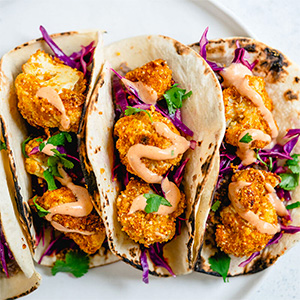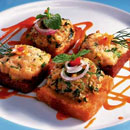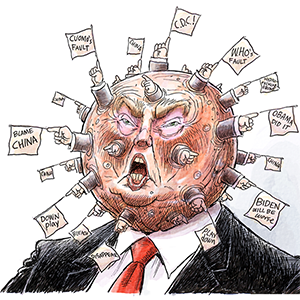Authors tell the unknown stories of Asian chefs in the White House
Published in Variety Menu
"Cooking to the President's Taste" (White House Historical Association, $45) was inspired by a fortuitous discovery.
Author Adrian Miller was researching another book, his James Beard Award-winning "The President's Kitchen Cabinet," when he came upon an "as told to" autobiography of chef Lee Ping Quan, who served under Presidents Warren Harding and Calvin Coolidge on the presidential yacht.
"I almost fell out of my chair," Miller said during a recent online press conference. "It was the most complete telling of a chef's story that we've ever had in presidential history up to that point."
For the book with the subtitle "Asian Heritage Chefs in White House History," he decided to retell and expand upon Quan's story to include a panoramic view of chefs of Asian background who had cooked for U.S. presidents, from Navy stewards like Quan to guest chefs who cooked for state dinners, to White House executive chefs like Cristeta Comerford, a Philippines native who served in the Obama White House.
Many of the book's 60 recipes are from Quan, who left behind a bewildering stash of more than 400 recipes — including Americanized Chinese dishes like chop suey, chow mein and eggrolls — as well as from more modern chefs. The daunting task of choosing, testing and adapting (especially in the case of the historical recipes) each one for the home cook fell to co-author Deborah Chang.
Chang, whose parents were from Taiwan, and Miller met at Stanford University as undergraduates and both went on to become lawyers. They fortuitously met again decades later, after Chang had gone to a Napa Valley culinary school, worked in restaurants and started a small catering company. She had been working in the tech industry for a decade when she reunited with Miller.
"This project looped me back into the culinary world, which has been fun," Chang said.
Especially for hard-to-decipher baking recipes, she got help from an old cooking school buddy, Scot Rice, who had trained in pastry making, and his students at Florian High School in Sacramento, Calif. The high school students helped test the recipes and gave their unbridled feedback, some of which Chang took into account.
Sometimes she had to draw a line to maintain a sense of historical authenticity.
Chang spoke with us by video call about her experiences in selecting and testing the book's recipes. The following is an edited transcript from that interview, with small sections taken from the press conference held by the White House Historical Association:
You call yourself "a recovering lawyer." What drew you to the culinary world?
You typically hear stories like, 'Oh, I've always liked to cook' or 'My parents cooked." And it wasn't anything like that. It was the beginning of a creative journey. Plus it was practical. I was like, I can learn how to cook, I should probably learn how to cook. I was in completely over my head.
It was a professional cooking school and I was definitely overwhelmed when I first got there, but it was really fun and I loved it. It was probably one of the funnest things that I've ever done in my life. And I was pretty bad. I mean, I don't think anyone thought I was going to make it.
Were there difficulties in translating historical recipes for a modern cook?
Lee Ping Quan's recipes were from about a hundred years ago. The ingredients that were available were very different. The tastes were different, and we're not even talking like home-cooked versus White House, but just what people thought was good was different. The technology was different.
The organization was hard to get through. Plus the details that he had sometimes were not applicable. He would spend [a lot of time on] how to make noodles for Chinese chow mein. But today, we could just go buy it. He had things on how to prepare different kinds of meat, from cleaning it on, whereas you can just go out and buy meat now.
And then he was very, very vague in areas that mattered — mostly in baking. For savory things, you can kind of figure it out. What was really hard was the baking recipes. Those were tested and failed many times: flat-out fails, like throw-up-your-hands-in-the-air fails.
In the book, you said you asked yourself: At what point do the recipes become so different that they're no longer Quan's? How do you know when to stop making changes?
That was always a question in my head, because you want to be historically accurate and you want the recipes to be Chef Quan's. They're not mine.
But at the same time, you want them to be workable, edible and have the reader and home cook have a good experience. So that was always the question, and I don't have a good answer to that other than I just knew when to stop.
How have our palates changed over the years?
There were some notable things that were in [Quan's] old cookbook that I kind of thought, 'Oh, no, no, no.' The salads and the fresh vegetables were very, very not modern. Bananas in a salad is just no. So I didn't include any banana salads.
He put this savory, fishy mixture in a watermelon basket. Just something like that where I was like, No. Or using a coconut as a shell. Those kinds of things I didn't think people would want to eat. His salad dressings were not really modern, so I had to adapt those.
There are several Chinese-inspired dishes in the book. Did you eat Chinese food at home when you were growing up?
Yes. My dad worked for Ford Motor Co., and I think at the time there were a lot of Chinese engineers with the big auto companies. And so we grew up in that community. I grew up very Chinese.
I went to Chinese school on the weekends. I ate Chinese food at home, I spoke Chinese at home. Even though there were not very many Chinese people or Asian people in the suburbs of Detroit at that time, I grew up with community like that.
As someone who grew up eating what I assume was fairly authentic Chinese food, how did you feel about Quan's Chinese-influenced recipes?
I thought it was really cool, and that's what drew me to the project, the Chinese part of it. It's [still] kind of the same, right? I feel like he must have been an influencer in his day. I decided to leave chop suey chop suey, even though no one really uses that term because it's kind of weird. But the concept of a stir fry, it still exists. That's a basic cooking method.
He was probably responsible for Chinese food in America, to a certain extent. And the fact that the presidents were willing to eat it is amazing.
As an Asian heritage chef yourself, were there things that you identified with or learned from in the histories of these other chefs?
My gosh, so much. First of all, they even existed. I had no idea. No idea, and I didn't know that they existed so long ago back in the Coolidge-Harding time. Then just how there were so many throughout the years, and their skill level is impressive. Their flavors were impressive. The degree of care and all of their recipes are so good.
What is really interesting over the decades is how being a professional chef has been elevated. And so it's really interesting to highlight historical people that have contributed to that. Asian Americans contributed to what I view to be a very high level, a leadership level [of cooking]. Bringing these Asian American recipes to the forefront is very important to me.
Lee Ping Quan's London Pound Cake
PG tested
This recipe takes close to two hours to bake, as Chef Quan's did. "He specified only a 'slow oven,' which we interpreted to be 300 degrees and even at 300 degrees, this cake does take a long time to bake," co-author Deborah Chang says.
6 egg whites, room temperature
1 1/2 cups granulated sugar
12 ounces (3 sticks) unsalted butter, room temperature
6 egg yolks, room temperature
1 1/2 cups unbleached flour, sifted
1/2 tablespoon baking powder
1 tablespoon vanilla extract
Preheat oven to 300 degrees
Prepare a greased loaf pan or a pan with parchment paper.
Beat egg whites until they form soft peaks. Set aside.
Cream together sugar and butter until slightly fluffy.
Add egg yolks one at a time, until combined.
In a separate bowl, whisk together flour and baking powder. Add a little at a time to the batter.
Add vanilla extract. If using a stand mixer, move the batter into a wide, shallow bowl. (Chang found the cake rose higher if a shallow bowl was used.)
Gently fold in the egg whites to eliminate the streaks with as few strokes as possible.
Put the loaf pan on a sheet pan and bake in the oven. Check after 60 minutes, then 80 and then 100 minutes. If the cake rises very high in volume, we suggest baking for two hours.
Top with lemon glaze or whipped cream and fresh fruit if you like.
Serves 8.
— Adapted from "Cooking to the President's Taste" by Adrian Miller and Deborah Chang
©2025 PG Publishing Co. Visit at post-gazette.com. Distributed by Tribune Content Agency, LLC.










Comments